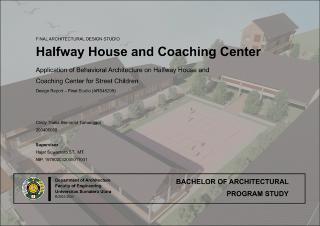| dc.contributor.advisor | Suwantoro, Hajar | |
| dc.contributor.author | Tumanggor, Cindy Thalia Bernadet | |
| dc.date.accessioned | 2025-05-02T09:01:00Z | |
| dc.date.available | 2025-05-02T09:01:00Z | |
| dc.date.issued | 2024 | |
| dc.identifier.uri | https://repositori.usu.ac.id/handle/123456789/103575 | |
| dc.description.abstract | The significant population of street children in Medan City reflects child welfare problems which are mainly triggered by economic factors. Shelters play a crucial role in providing shelter and support for them. The concept of behavioral architecture in shelters and development centers for street children aims to provide adequate facilities that are appropriate to the behavior of street children, as well as provide physical and psychological comfort through architectural design, interior space, outdoor space, and circulation in the Street Children Community Center. This research uses qualitative methods by collecting data through observation, interviews, and literature study. The research results show that behavioral architecture can be applied to the design of shelter houses in Medan City. | en_US |
| dc.language.iso | en | en_US |
| dc.publisher | Universitas Sumatera Utara | en_US |
| dc.subject | Street Children | en_US |
| dc.subject | Behavioral Architecture | en_US |
| dc.subject | Facilities | en_US |
| dc.subject | Community | en_US |
| dc.title | Application of Behavioral Architecture on Halfway House and Coaching Center for Street Children | en_US |
| dc.type | Thesis | en_US |
| dc.identifier.nim | NIM200406068 | |
| dc.identifier.nidn | NIDN0003027902 | |
| dc.identifier.kodeprodi | KODEPRODI23901#Profesi Arsitek | |
| dc.description.pages | 150 Pages | en_US |
| dc.description.type | Karya Tulis Profesi | en_US |
| dc.subject.sdgs | SDGs 11. Sustainable Cities And Communities | en_US |


